Introduction
Following the Battle of Punta Stilo (Encounter off Calabria), the Regia Marina had decisively implemented the policy of “Fleet in Being”. The theory behind this doctrine assumed that the threat of a powerful navy would be enough to deter the enemy from conducting an active campaign. Perhaps this approach reflected the general expectations of the Italian armed forces, which saw this war as a short prelude to a very bountiful armistice. To be fair, the various armed forces, perhaps partially excluding the Regia Aeronautica, were very well aware of the limitations of the Italian war machine. It is surprising to see that the Regia Marina, which knew that a prolonged confrontation would bring about her demise, did not actively pursued a decisive confrontation against the British Navy. Perhaps, the memories of Lissa had not yet faded.
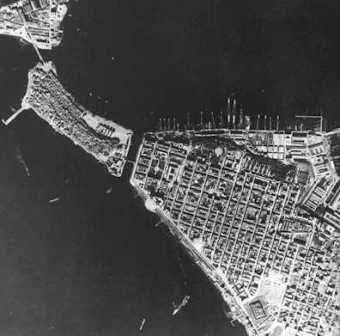
Aerial picture of Taranto
Different sources attribute Italian inactivity to the fact that the two Littorio Class battleships, which had just completed training, were not fully prepared for action. Undoubtedly, during early July these ships had experienced serious technical problems, including the failure of one of the main turrets due to water infiltration, but by early November these ships should have been considered fully readied.
Perhaps referential fear toward the Royal Navy kept Supermarina from acting with more resolution, or perhaps it was a more complex collection of reasons. Nevertheless, Italian inactivity prompted British action and so evolved the operation, which led to the deadly aerial attack against the naval base of Taranto.
The war in the Mediterranean, after a period of relative inactivity, suddenly surged after the October 28 ultimatum Italy imposed on Greece. The Italian request for the use of Greek bases was unacceptable and a Greek refusal was expected. Great Britain was immediately asked to step up assistance, while Italian troops poured into Greece from the Albanian front. The Greek campaign had not been coordinated with the German Ally and not only did it created friction between the two dictators, it also led to an embarrassing Italian debacle on land.
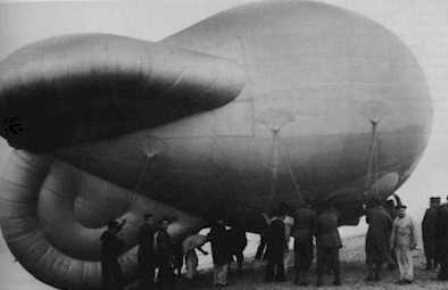
Italian Barrage Balloon
During the Ethiopian crisis, when Great Britain and Italy appeared to be on the verge of an armed conflict, the Royal Navy conducted studies regarding the possibility of attacking the Italian naval base of Taranto. The plan, due to the resolution of the international political situation, was filed away, but not for long. Towards the end of the year 1940, Rear-Admiral Lyster began, once again, to plan an aerial attack on the large naval base.
The attack against the Italian naval base of Taranto, codenamed “Operation Judgment”, as we have already mentioned, was part of a greater plan of action which saw British naval vessels crisscross the Mediterranean. Operation M.B. 8, and along with it the Taranto’s raid, were scheduled around the 21st of October, Trafalgar day. Several technical problems, including a fire aboard the Illustrious and the withdrawal of the aircraft carrier Eagle(1), caused a postponement. Some of the air complements from the Eagle were transferred aboard the Illustrious
It is now known that the damages to the Eagle dated back to the battle of Punta Stilo when several near misses caused serious structural damage to the ship, including the fuel system.
British Aerial Reconnaissance
The success of the attack relied mostly on the accuracy and timeliness of the air reconnaissance over the Italian base. The effectiveness of the mission had been greatly improved with the arrival in the Mediterranean theatre of the new aircraft Maryland. Two days before the attack, a Maryland from Malta confirmed that the Italian fleet was still in Taranto and that another battleship had reached port, bringing the total to six.
Maryland was the British denomination for the American-built Glenn Martin which was produced by the Glenn Martin Aircraft Company of Baltimore, Maryland. These planes had been produced for the French Air Force, but the German occupation of France cause the final shipment to be diverted to Great Britain where the original crates were opened and the content assembled.
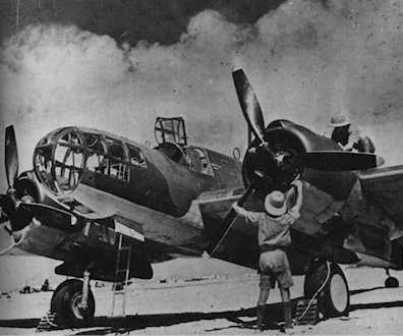
Glenn Martin “Maryland”
Three of these aircraft were sent to the Mediterranean after a long flight over occupied France and Sardinia. The flight took place on the 6th of September, 13 days ahead of schedule, and took all night. Squadron Leader Ernest Alfred Whitley had just transferred from a previous assignment with the N.22 Beaufort Torpedo Squadron of the RAF Coastal Command. The new unit was designated No.431 General Reconnaissance Flight and was based in Malta.The other pilots were Officer Foxton and Flight Sergeant Bibby.
This twin-engine bomber was never used by the US Air Force, it was ordered only by France and Britain. The designation A-22 was used for aircraft built under lend-lease contracts. The Maryland was a sleek bomber with a good performance, but a very cramped fuselage; hence the development of the A-30 Baltimore with a deeper fuselage. About 450 were built.
Italian Defences
In a report sent by Supermarina to “Comando Supremo” immediately following the British attack, the defenses of the military stronghold were described as follows:
Antiaircraft defenses fully active and including:
21 batteries armed with 101 mm guns
68 machine-gun installations for a total of 84 barrels both on fixed and floating positions
109 light machine-guns both in fixed and floating positions.
Antiaircraft obstructions consisting of 27 round balloons, 16 moored west and north of the ships on the Tarantola jetty. 11 moored along the eastern part of the same jetty.
The balloons should have been 90, but bad weather in the days before the attack had caused about 60 balloons to be lost. Due to a shortage in the local production of hydrogen, spare barrage balloons could not be deployed. Reportedly, the actual number of balloon in the air the night of the attack was 27. The original balloons were spherical and therefore not really aerodynamic, while later pictures show that the Italians implemented a design similar to the one already in use in Great Britain with the balloon looking like a rugby ball with fins.
Network of aerial detection
Included 13 stations equipped with listening devices, two of which were directly connected to projectors. Of the 22 projectors available, mostly of recent construction, some were installed on land and others on floating pontoons. Projectors installed aboard most ships could provide further assistance
Anti-torpedo netting
Of the 12,800 meters of nets originally intended for the defense of ships moored in Mar Grande (the outer lagoon), only 4,200 were installed. An additional 2,900 meters had recently arrived but had not been deployed. Domestic manufacturing of this netting amounted to about 3,600 meters per month and therefore the completion of the protective barriers was not expected before sometime in 1941. These nets were only 10 meters deep, thus leaving a space of about 5 meters between the end of the net and the bottom of the lagoon.
All naval military units belonging to the various squadrons were ready to get under way in less than three hours. Also, all units had their weapons manned and ammunitions were already loaded. In case of alarm, all ships were to stay at their existing mooring which, according to the authorities, had been studied to provide for the highest degree of defense. Guns aboard ships were not to open fire along with the local defense to avoid providing the enemy with easily identifiable targets. Projectors installed aboard ships were to be used to blind the incoming planes and, during nights of full moon, could be kept lit at will. Naturally, allowing these projectors to operate when the night was already fluorescent provided for any significant decrement to their defenses.
The port had already experienced innumerable air raid alarms, mostly triggered by reconnaissance planes. All ships were lying at single anchor, meaning that only one of the two extremities of the ship, in this case the bow, was secured, thus allowing the ship to rotate 360 degrees. All these defensive measures were based on some fundamentally flawed assumptions. First, the Italian did not know that the British had overcome a problem known as the “deep”, meaning the sudden diving of a torpedo, launched from an airplane, into the water before re-emerging. Second, they grossly underestimated the minimal distance from the target required for a launch .
It is interesting to note that in his lesser-known book “Aerial Warfare”, published in 1943, Hal Goodwin does not cite any Italian torpedo bomber. This was not an accident. Despite the notoriety gained by the famous Savoia Marchetti s.79, the Italian air force entered the war without a single torpedo plane. This lack of vision not only caused the Italians to fall behind in this, soon-to-become, crucial warfare, but also slowed down the process of creating counter measures. Simply, the Italian Navy did not know that a torpedo plane flying level with the water at a slower speed and in a straight path could drop a torpedo without having the weapon dip more than 15 meters into the water. Also unknown to the Italians, a torpedo could now be triggered not only by contact, but also by proximity using a device called duplex (dual action). Even if fully deployed, Italian netting was only 10 meters deep and, therefore, British torpedoes could easily steer under it. If they actually did is an open question. By looking at the position of the nets and at the trajectory of the torpedoes, it does not look like netting was an issue.
It is known that, following the attack, some of the British torpedoes were recovered and it would be safe to assume that the Italian industry was immediately made aware of these new technological advantages. Most of the defense measures implemented in Taranto were outlined in a dispatch numbered 35901, which was issued following the attacks on Tobruk and Augusta. The commander of Taranto, Adm. Antonio Pasetti, asserted that a full rectangular fence to be constructed around each ship would have provided the only effective defenses. This measure, judged by the chief of the 1st Squadron to be too radical, was not implemented due to assumed difficulties in letting ships in and out of this defensive perimeter. Nevertheless, this polemic was purely rhetorical because there was not enough net available.
Le azioni navali in Mediterraneo, Adm. Giuseppe Fioravanzo, page 226.
The Attack
Leading to the attack
Before reaching her assigned position, the Illustrious had to endure problems with her aircraft, which, if not brought under control, could have easily jeopardized the whole action. At 12:19 of the 9th, a Swordfish launched by the Illustrious experienced engine trouble and was forced to crash land near the Warspite. On the 10th, at around 7:00 another Swordfish experienced similar problems and was lost. The same day, Italian planes continued attacking the British force, now fast approaching Malta, but around mid-day a Cant 501 was lost. A later attack conducted by ten bombers did not cause any damage.
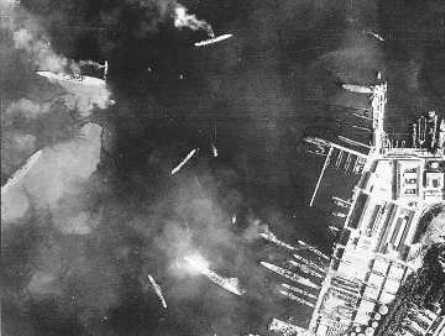
Aerial picture
At mid-day on the 11th, the fleet was already halfway back toward Crete and, during a routine flight, another Swordfish was lost. The situation had become worrisome; three planes of the already dwindling task force had been lost. The three vehicles belonged to the 819th Squadron and had been refueled from the same fuel depot. After an inspection, it was discovered that the gasoline in the depot was contaminated with water, sand and mold.
The attack
The night of November 11th, a few miles off the Greek island of Cephalonia, about 170 miles from Taranto, the Illustrious released her Swordfish aircraft which, undetected, reached Taranto in two waves of 12 and 9 airplanes each. One of the planes in the first wave, due to a navigational error, reached Taranto 15 minutes before the rest of the squadron, causing the antiaircraft defenses to go into full alert.
First Wave
Flares and bombs
At 10:58 PM the two flare-launchers started their action. The two swordfish (Kiggell, L4P and Lamb L5B), flew over Cape San Vito, coasted the southern boundary of Mar Grande and began launching flares near the point in which the Tarantola’s jetty meets land. Each plane dropped 9 flares, which provided a good back stage illumination for the incoming torpedo bombers. The dropping stopped just past the end of the balloon barrage, slightly north of the Doria. After a sharp turn, the two planes zigzagged back towards the large oil depot where they conducted an unsuccessful diving attack against an oil depot, and then headed back toward the safety of the sea.
Torpedoes
Williamson-Scarlet, L4A
At 23:14, crewmembers aboard the destroyer Fulmine witnessed the downing of Williamson-Scarlet’s swordfish. Their plane, after a slow descent with the engine cut off, had successfully launched a torpedo toward the Cavour, but it had been stricken by anti-airplane gunfire from the Cesare. The two crewmembers were later rescued. They had flown over San Pietro Island, north of the smaller San Pietro island and almost straight across the bay through the Tarantola balloon barrage; the torpedo had literally squeezed between the destroyer Fulmine and the Lampo. The two crewmembers were picked up by dock workers, roughed up and then delivered to the Navy.
Maculay-Wray L4R and Sparke-Neale L4C
These crews followed the same approach route taken by their leader Williams. Instead of launching at the already stricken Cavour, their weapons were aimed at the further back-moored Doria. The planes flew between the destroyer Lampo and Baleno, and retracing their original route, they returned toward the Bay of Taranto. At 23:15, aboard the Doria, crew witnessed two explosions just near the ships’ bow. These explosions were mistaken for bombs, but it is safe to assume that they were actually caused by the torpedoes exploding upon contact with the bottom. These crews could have easily aimed at the Vittorio Veneto, which was in slightly deeper waters.
Kemp-Baley L4K
Chronologically speaking, the attack which followed was the one conducted by Lt. N.M. Kemp. He flew north of San Pietro Island, north of the balloon barrage protecting the heavy cruisers to then sharply fly south towards the battleships. His altitude, estimated at about 1200 meters during the approach, suddenly decreased to a few meters before the launch. The torpedo quickly ran toward the Littorio striking the ship on her starboard bow. The crew rapidly left the bullet-infested Mar Grande, flying straight to the south near the Capo San Vito.
Swayne-Buscall L4M
Their maneuver was different from the one by Kemp-Bailey, but achieved the same result torpedoing the Littorio’s starboard stern. Their flight path took them north of the San Pietro island, south of the “Secca della Sirena” to then make a sweeping 180 degree turn over the Littorio. Their escape route took them over the San Pietro Island and back into the Gulf of Taranto.
Maud-Bull E4F
This plane was the last one to the scene. It flew over Punta Rondinella, north of the cruisers and then squeezed a torpedo between the Duilio and the Littorio towards the Vittorio Veneto. The weapon entered the water but then exploded upon contact with the bottom, probably victim of a heavy “sack”. The plane went back into the Gulf of Taranto, flying over the Island of San Pietro.
At 23:15 Patch-Goodwin E5A conducted at attack against the Libeccio in Mar Piccolo, hitting the target which was not seriously damaged since the weapon did not detonate. The hydroplane terminal was attacked by Sarra-Bowker L4L who destroyed two planes and caused a fire which was controlled within 15 minutes.
The first wave was over; damage was great and soon to be worse. The Littorio had received two hits and it was slowly going down by the bow, while the Cavour was been flooded by tons of water. While part of the aircraft of the first wave was conducting the primary attack against the units moored in Mar Grande, a secondary group conducted a bomb attack against units in Mar Piccolo.
Between the attacks
The anti-aircraft guns were silenced between 23:20 and 23:35, but soon planes from the second wave began making their appearance over the sky of Taranto. More planes dropped bombs near the destroyers between 23:30 and 23:40. All weapons fell about 20 to 30 meters short of their target. These were probably the bombs launched by Mardeal-Ferreira and Murray-Paine. Of the two planes, the first repeated the attack twice, due to an early problem with the release mechanism.
Second Wave
Flares and bombs
Hamilton-Weekes L5B and Skelton-Perkins L4F
At 23:35 several airplanes were once again spotted in the skies over Taranto. Between 23:50 and 23:55 seven or eight more flares were dropped by these two planes starting, more or less, at the same point os the previous one, but terminating further north. Following the launch of the flares, the two planes conducted an unsuccessful attack against the oil depot at the naval arsenal.
Torpedoes
Lea-Jones L5H
At 23:55, with the engine cut off, their airplane crossed Punta Rondinella and dropped a torpedo against the Duilio, the first of the battleships moored in Mar Grande. At around midnight, the ship was violently shaken following a hit near the bow.
Hale-Carline L5A or Torrens Spence-Button L5K
A minute past midnight, a torpedo from one of these two planes hit the Littorio for the third time. To this day, it is not known which crew scored the hit.
Wellham-Humphreys E5H
At the same time of the previous two crew, these planes conducted an attack against the Vittorio Veneto, but without scoring .
Bayley-Slaughter E4H
Their airplane was hit by the anti-aircraft fire and plunged into the water. The body of the commander was found and buried with full military honor, while the body of the co-pilot was never found.
Mar Piccolo
In addition to the flare-dropping planes, Clifford-Going L5F conducted a bomb attack against the Trento and the Miraglia. One of the bombs hit the Trento near the forward 10 mm gun causing minor damage, but failing to explode. At 1:22 the alarm was finally called off and the cleanup work immediately began.
Damages and Casualties
he day following the attack the remaining battleships, Giulio Cesare, Vittorio Veneto and Andrea Doria were immediately transferred to Naples, while the salvage operations began on the damaged ones. The Littorio and the Caio Duilio were relatively easy to recover and within a month these ships were already afloat. The Cavour, on the other hand, required a significant investment in time and resources.
R.N. Cavour
The Cavour was moored in the “Mar Grande”, Taranto’s larger lagoon. The ship was hit by a torpedo launched by the Swordfish of Williamson-Scarlet. The explosion took place near the keel and caused a gash of about 12 x 8 meter, in the proximity of the forward ammunition depot.
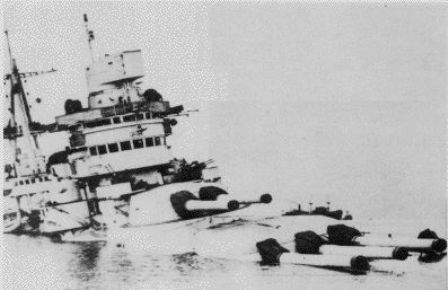
R.N. Cavour
The unit, considered seriously damaged, was brought closer to shore, but not close enough to avoid partial sinking. After the unit had settled to the bottom, water reached the main deck thus submerging most of the hull. Rescue work started immediately and, already on November 13th, crews were at work.
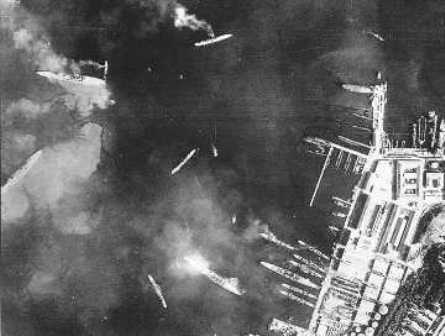
Aerial picture
Towards the end of 1941 the unit was, once again, seaworthy and it was transferred to Trieste for further repairs and some modernization work. On September 8th, following orders received from the Italian high command, the crew of the Cavour did not scuttle the unit since it was more than 6 months away from being operation. On the 10th, the Germans took control of the battleship. On February 15, 1945, during a heavy aerial bombardment, the ship was hit by several bombs, capsized and finally sunk. It was later scrapped in 1946 and stricken from role on February 27, 1947.
R.N. Duilio
Duilio was hit at around midnight by a torpedo launched from about 400 meters. The explosion caused a hole of about 11 x 7 meters to the right near the forward ammunition depots. At around 4:45 AM of the 12th, the ship was run aground to avoid sinking.
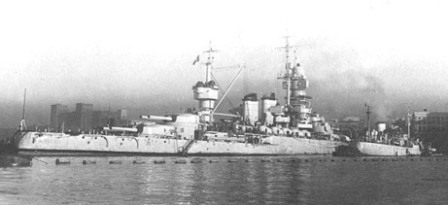
R.N. Duilio
In January of the following year, the unit was once again afloat. On the 3rd of February the unit entered dry dock. During November and January the ship actively participated to the defense of Taranto providing for antiaircraft coverage. On January 26th, the battleship left Taranto, and two days later reached Genoa.
R.N. Littorio
The Littorio was hit by a total of three torpedoes. two to starboard, one under the second turret, near frame 192 and causing damage from frame 187 through frame 192, and the second one aft of the first turret near frame 163, causing damage from frame 159 through frame 165.
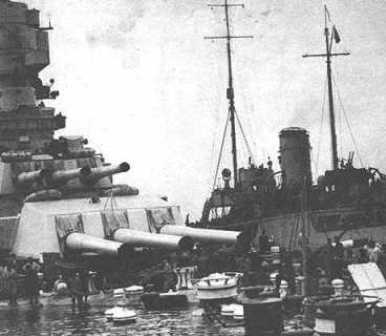
R.N. Littorio
The third weapon hit the ship to port near the rudder control mechanism, causing the partial destruction of the primary rudder.
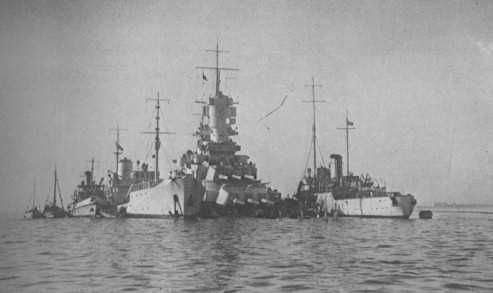
R.N. Littorio
Despite the heavy damage, the ship was never in peril of sinking, but it was nevertheless decided to let it rest on the muddy bottom of a shallow section of the harbor. Repair work was hampered by the presence of unexploded weapons.
Additional Damage
The destroyer Libeccio and the heavy cruiser Trento were hit by bombs which failed to explode. Bombs fallen near the airport caused the loss of two hydroplanes and a small fire. Minor damages were recorded near the docks, the oil fuel depot and the aqueduct. Several bombs fell in a residential area near the “Ospedale Civile” (hospital), causing several casualties amongst the civilian population.
Casualties
In addition to the civilian population, the Littorio listed 32 casualties, the Cavour 17 and the Duilio 3.